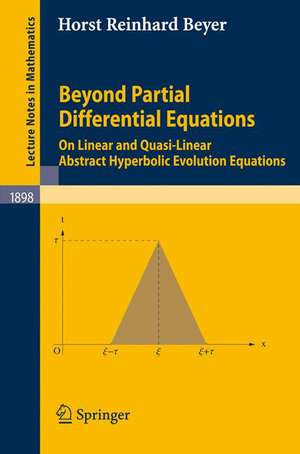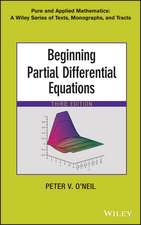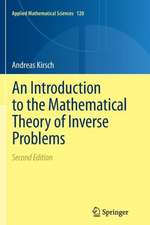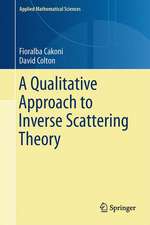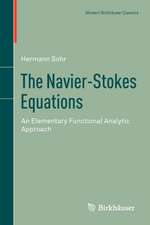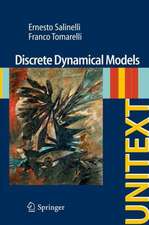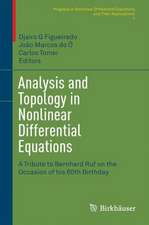Beyond Partial Differential Equations: On Linear and Quasi-Linear Abstract Hyperbolic Evolution Equations: Lecture Notes in Mathematics, cartea 1898
Autor Horst Reinhard Beyeren Limba Engleză Paperback – 4 apr 2007
Din seria Lecture Notes in Mathematics
- 17%
 Preț: 360.42 lei
Preț: 360.42 lei -
 Preț: 459.92 lei
Preț: 459.92 lei -
 Preț: 121.41 lei
Preț: 121.41 lei -
 Preț: 175.68 lei
Preț: 175.68 lei -
 Preț: 197.00 lei
Preț: 197.00 lei -
 Preț: 279.76 lei
Preț: 279.76 lei -
 Preț: 477.65 lei
Preț: 477.65 lei - 17%
 Preț: 361.88 lei
Preț: 361.88 lei -
 Preț: 252.37 lei
Preț: 252.37 lei -
 Preț: 353.99 lei
Preț: 353.99 lei -
 Preț: 138.88 lei
Preț: 138.88 lei -
 Preț: 152.61 lei
Preț: 152.61 lei -
 Preț: 116.67 lei
Preț: 116.67 lei -
 Preț: 102.77 lei
Preț: 102.77 lei - 17%
 Preț: 365.52 lei
Preț: 365.52 lei -
 Preț: 396.75 lei
Preț: 396.75 lei - 17%
 Preț: 362.12 lei
Preț: 362.12 lei -
 Preț: 396.11 lei
Preț: 396.11 lei -
 Preț: 357.78 lei
Preț: 357.78 lei - 17%
 Preț: 362.31 lei
Preț: 362.31 lei -
 Preț: 403.80 lei
Preț: 403.80 lei - 17%
 Preț: 361.70 lei
Preț: 361.70 lei -
 Preț: 499.87 lei
Preț: 499.87 lei -
 Preț: 457.03 lei
Preț: 457.03 lei -
 Preț: 395.90 lei
Preț: 395.90 lei -
 Preț: 459.00 lei
Preț: 459.00 lei -
 Preț: 487.57 lei
Preț: 487.57 lei -
 Preț: 424.01 lei
Preț: 424.01 lei -
 Preț: 487.57 lei
Preț: 487.57 lei -
 Preț: 330.55 lei
Preț: 330.55 lei -
 Preț: 325.75 lei
Preț: 325.75 lei -
 Preț: 350.30 lei
Preț: 350.30 lei -
 Preț: 331.31 lei
Preț: 331.31 lei -
 Preț: 408.37 lei
Preț: 408.37 lei -
 Preț: 328.25 lei
Preț: 328.25 lei -
 Preț: 421.28 lei
Preț: 421.28 lei -
 Preț: 276.08 lei
Preț: 276.08 lei -
 Preț: 424.60 lei
Preț: 424.60 lei -
 Preț: 422.05 lei
Preț: 422.05 lei -
 Preț: 505.01 lei
Preț: 505.01 lei -
 Preț: 422.05 lei
Preț: 422.05 lei -
 Preț: 274.93 lei
Preț: 274.93 lei -
 Preț: 335.16 lei
Preț: 335.16 lei -
 Preț: 422.27 lei
Preț: 422.27 lei -
 Preț: 497.49 lei
Preț: 497.49 lei -
 Preț: 272.81 lei
Preț: 272.81 lei -
 Preț: 428.04 lei
Preț: 428.04 lei -
 Preț: 376.22 lei
Preț: 376.22 lei -
 Preț: 427.10 lei
Preț: 427.10 lei -
 Preț: 325.92 lei
Preț: 325.92 lei
Preț: 489.22 lei
Nou
Puncte Express: 734
Preț estimativ în valută:
93.61€ • 96.58$ • 78.12£
93.61€ • 96.58$ • 78.12£
Carte tipărită la comandă
Livrare economică 26 martie-09 aprilie
Preluare comenzi: 021 569.72.76
Specificații
ISBN-13: 9783540711285
ISBN-10: 3540711287
Pagini: 297
Ilustrații: XIV, 283 p. With online files/update.
Dimensiuni: 155 x 235 x 17 mm
Greutate: 0.46 kg
Ediția:2007
Editura: Springer Berlin, Heidelberg
Colecția Springer
Seria Lecture Notes in Mathematics
Locul publicării:Berlin, Heidelberg, Germany
ISBN-10: 3540711287
Pagini: 297
Ilustrații: XIV, 283 p. With online files/update.
Dimensiuni: 155 x 235 x 17 mm
Greutate: 0.46 kg
Ediția:2007
Editura: Springer Berlin, Heidelberg
Colecția Springer
Seria Lecture Notes in Mathematics
Locul publicării:Berlin, Heidelberg, Germany
Public țintă
ResearchCuprins
Conventions.- Mathematical Introduction.- Prerequisites.- Strongly Continuous Semigroups.- Examples of Generators of Strongly Continuous Semigroups.- Intertwining Relations, Operator Homomorphisms.- Examples of Constrained Systems.- Kernels, Chains, and Evolution Operators.- The Linear Evolution Equation.- Examples of Linear Evolution Equations.- The Quasi-Linear Evolution Equation.- Examples of Quasi-Linear Evolution Equations.
Recenzii
From the reviews:
"In the monograph under review, designed as a textbook for graduate students, the author aims to build up the theory in a straightforward way in view of physical applications. … The material covered in the book was used in a two-semester course for graduate students. The book is a good summary of the most important facts of the theory of evolution equations, and is also a good source of information for researchers looking for new applications of this theory." (András Bátkai, Mathematical Reviews, Issue 2008 h)
"This well-written work is the outgrowth of a two-semester course on linear semigroup methods, linear and quasi-linear hyperbolic systems of partial differential equations, and the abstract theory of evolution equations … . Although the text was written for truly advanced graduate students, it contains a wealth of well presented results on semigroup theory of evolution equations … and will therefore serve as a valuable resource for researchers in mathematics and theoretical physics as well." (Thomas Hagen, Zentralblatt MATH, Vol. 1144, 2008)
"In the monograph under review, designed as a textbook for graduate students, the author aims to build up the theory in a straightforward way in view of physical applications. … The material covered in the book was used in a two-semester course for graduate students. The book is a good summary of the most important facts of the theory of evolution equations, and is also a good source of information for researchers looking for new applications of this theory." (András Bátkai, Mathematical Reviews, Issue 2008 h)
"This well-written work is the outgrowth of a two-semester course on linear semigroup methods, linear and quasi-linear hyperbolic systems of partial differential equations, and the abstract theory of evolution equations … . Although the text was written for truly advanced graduate students, it contains a wealth of well presented results on semigroup theory of evolution equations … and will therefore serve as a valuable resource for researchers in mathematics and theoretical physics as well." (Thomas Hagen, Zentralblatt MATH, Vol. 1144, 2008)
Textul de pe ultima copertă
The present volume is self-contained and introduces to the treatment of linear and nonlinear (quasi-linear) abstract evolution equations by methods from the theory of strongly continuous semigroups. The theoretical part is accessible to graduate students with basic knowledge in functional analysis. Only some examples require more specialized knowledge from the spectral theory of linear, self-adjoint operators in Hilbert spaces. Particular stress is on equations of the hyperbolic type since considerably less often treated in the literature. Also, evolution equations from fundamental physics need to be compatible with the theory of special relativity and therefore are of hyperbolic type. Throughout, detailed applications are given to hyperbolic partial differential equations occurring in problems of current theoretical physics, in particular to Hermitian hyperbolic systems. This volume is thus also of interest to readers from theoretical physics.
Caracteristici
Includes supplementary material: sn.pub/extras
